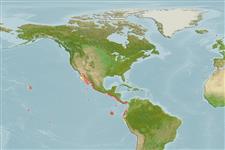>
Pleuronectiformes (Flatfishes) >
Cynoglossidae (Tonguefishes) > Symphurinae
Etymology: Symphurus: Greek, syn, symphysis = grown together + Greek, oura = tail (Ref. 45335).
More on authors: Jordan & Bollman.
Environment: milieu / climate zone / Tiefenbereich / distribution range
Ökologie
seewasser riff-verbunden; tiefenbereich 1 - 200 m (Ref. 37955), usually 1 - 80 m (Ref. 9294). Tropical; 33°N - 8°S, 158°W - 7°W (Ref. 56829)
Eastern Pacific: Gulf of California and Bahía Magdalena, Mexico to Peru, including the Galapagos Islands (Ref. 9294).
Size / Gewicht / Alter
Geschlechtsreife: Lm ? range ? - ? cm
Max length : 14.4 cm SL Männchen/unbestimmt; (Ref. 9294); common length : 12.0 cm SL Männchen/unbestimmt; (Ref. 9294)
Rückenflossenstacheln (insgesamt) : 0; Rückenflossenweichstrahlen (insgesamt) : 89 - 98; Afterflossenstacheln: 0; Afterflossenweichstrahlen: 75 - 82; Wirbelzahl: 49 - 53.
Body shape (shape guide): short and / or deep.
Found over a variety of substrates (Ref. 9294). Small specimens may be taken from tide pools and other shallow habitats (Ref. 9294). Feeds mainly on small benthic invertebrates (Ref. 28023).
Life cycle and mating behavior
Geschlechtsreife | Fortpflanzung | Ablaichen | Eier | Fecundity | Larven
Munroe, T.A., F. Krupp and M. Schneider, 1995. Cynoglossidae. Lenguas, lenguetas. p. 1039-1059. In W. Fischer, F. Krupp, W. Schneider, C. Sommer, K.E. Carpenter and V. Niem (eds.) Guia FAO para Identification de Especies para lo Fines de la Pesca. Pacifico Centro-Oriental. 3 Vols. FAO, Rome. (Ref. 9294)
IUCN Rote Liste Status (Ref. 130435: Version 2025-1)
Bedrohung für Menschen
Harmless
Nutzung durch Menschen
Fischereien: weniger kommerziell
Tools
Zusatzinformationen
Download XML
Internet Quellen
Estimates based on models
Preferred temperature (Ref.
123201): 17 - 28.9, mean 24.5 °C (based on 216 cells).
Phylogenetic diversity index (Ref.
82804): PD
50 = 0.5000 [Uniqueness, from 0.5 = low to 2.0 = high].
Bayesian length-weight: a=0.01072 (0.00507 - 0.02267), b=3.11 (2.92 - 3.30), in cm total length, based on LWR estimates for this (Sub)family-body shape (Ref.
93245).
Trophic level (Ref.
69278): 3.5 ±0.37 se; based on food items.
Widerstandsfähigkeit (Ref.
120179): hoch, Verdopplung der Population dauert weniger als 15 Monate. (Preliminary K or Fecundity.).
Fishing Vulnerability (Ref.
59153): Low vulnerability (10 of 100).
🛈
Nutrients (Ref.
124155): Calcium = 95.9 [36.6, 184.7] mg/100g; Iron = 0.689 [0.311, 1.229] mg/100g; Protein = 18.3 [16.1, 20.7] %; Omega3 = 0.104 [0.052, 0.209] g/100g; Selenium = 40.2 [19.7, 82.8] μg/100g; VitaminA = 68.5 [17.3, 289.0] μg/100g; Zinc = 1.25 [0.81, 1.84] mg/100g (wet weight);
